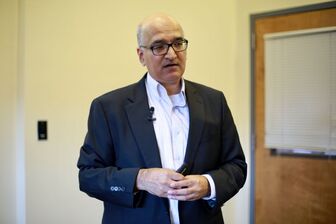|
Hiring the right candidate for a job is hard, especially if it's for a high-level position. Whomever you hire will either help you win or lose; hence, the stakes are very high. When hiring, there are usually three types of candidates you end up considering: 1) Candidates who are NOT interested. 2) Candidates who really want the job. 3) Candidates who are interested. In this blog post, I focus on #1, those who are not seeking the job you have or are even interested in the beginning. For you to get these candidates, you need a lot of skills besides sales. In future posts, I will cover #2 and #3. Candidates who fall in to category #1 have no competition and it is up to them whether they take the job. Note, this position is not advertised. The only person who knows about this position is the person who is hiring. And this happens at high-level, mid-level and low-level. You want to get into this category by letting people know you are worth the bet. Why target those who are not interested? They are likely to help you win if you can persuade them to work for you. It won't be easy. The uninterested candidates require time, patience, flexibility, and gentle persuasion. If you want to be an effective leader, you must do whatever it takes to get these people on your team. You see this in football, both NFL and college. The winning coaches have outstanding assistant coaches. All good coaches want to work for Bill Belichick, head coach of NFL's New England Patriots, and Nick Saban, head coach of the University of Alabama. If an assistant coach is good and lucky to get to work for these two great coaches and help them win, that assistant coach will have an excellent shot at getting the head coaching job either in the NFL or college. It's no different in business and politics. In this post, I use as an example of how Barack Obama got Joe Biden to become his vice president. I show the ten steps that are required to entice talent and demonstrate you are indeed an effective leader. The source for this post is Joe Biden's book, Promise Me, Dad. The candidates are going to go through these three phases. First, the candidate is going to go from not interested to interested. Second, the candidate is going to go from interested to serious consideration. Third, the candidate is going to go from serious consideration to acceptance. Below you will see what you have to do to take the candidate through these three steps. If you sell too hard or close to fast, it can backfire. Remember, the uninterested candidates have options so you have to foremost develop a relationship. You have to show that you are a good bet. Steps To Hire Someone Who Does Not Want the Job 1) Express Interest in Hiring Barack Obama, after he had secured the Democratic nomination in 2008, contacted Joe Biden to vet him for vice president. Joe Biden's initial response was that he was not interested. Though Obama made it appear that Biden was the leading candidate and tried to close him by telling him that "This is real...But I need an answer right now." Joe Biden said, "Then the answer is no." What do you do if you were Obama? Move on to other candidates or persevere? This must have been hard for Obama to be rejected right after he locked up the Democratic nomination. If this happened to us, our ego is likely to get in the way. But you must learn to suppress your ego when you are trying to get talent if you want to be an effective leader. The uninterested candidates are going to be very challenging since they are not looking for a change. They are happy and secure where they are. Your work is cut out for you. Until they feel you care about their well being and future, they are not likely to want to take you or the job seriously. 2) Keep Trying Don't give up, if rejected. It's a long game. If you want to be successful, then hiring has to be one of your strengths. Talent is rare so you have to work hard to get those that you believe will make a difference. If you can't assemble an "A" team and get them to work well together, you are likely to fail and, worse, be blamed for failure. To get talent, you must be humble, patient, and flexible. 3) Show Patience If you want someone that is hard to get, you have to be patient since that person does not care if you don't hire him. He has to feel like he can make a difference. This takes some intense trust-building. Also, you must show empathy by urging the person to talk it over with the family. Why? Others close to the person are more likely to better persuade the candidate than you. They will provide a different perspective that can easily cut through. In Joe Biden's case, his sons wanted him to run with Obama. They felt---and were proven right--- that Biden can help Obama win Pennsylvania, Ohio, and Florida. His wife Jill was relieved that it was not the Secretary of State job since that would require a lot of traveling. But his mother may have been most effective in persuading Biden to take the VP job seriously when she said, "So let me get this straight, honey. The first African American in history who has a chance to be president says he needs your help to win—and you said no." So after talking to family, he started doing some serious due diligence. Pro: Make history by helping elect the first African American nominee. Con: The vice president position has been a butt of all kinds of jokes. Challenge: Reinvent the vice president position to make it work for both. There was one more thing that Biden had to overcome: he had not worked for a boss for several decades. When he brought this concern to his wife, she said, "C'mon, Joe... Grow up." Joe Biden went from not interested to interested. He finally agreed to be vetted but still wasn't committed. He still needed to have a one on one with Obama to discuss Obama's vision and priorities for the country and what role he envisioned for Biden. They were now entering a trust-building phase of the hiring process. 4) Develop Rapport Biden met with Obama and wanted to understand what Obama's expectations were. He found out that Obama wanted his help with foreign policy, an area Biden was strong in. Biden liked Obama's focus on helping the middle class. After their one on one meetings, Biden had a better understanding of Obama's vision for the future and the role he saw Biden playing. Biden was convinced that Obama was honest and could be a good president. Biden felt he could help Obama not only win but govern. But he still needed to be comfortable with the role that would make him happy. Joe Biden went from interested to giving the job a serious consideration. 5) Redefine Job Joe Biden liked Obama, but he still had not defined his role to make him accept the job. Joe Biden had experience in many areas based on his years in the senate, so he felt he can help Obama in all areas. Here is how he defined his role to Obama: "I want to be the last guy in the room on every major decision... You're president. I'm not. I get it. But if it's my experience you're looking for, I want to be the last guy to make the case." Obama agreed and got the man he wanted to be his vice president. They were both happy. But now they had to make it work. You can stop here and say that you got the person you wanted, but you will not be able to attract talent in the future. You must do more. And the next five steps are what you have to do to continue to attract and develop talent to remain an effective leader. 6) Build Trust Trust does not happen with one meeting. It has to be built and nurtured. And that's why Joe Biden wanted to have a weekly lunch meeting with Obama. It worked. It is something that not only helped them develop a strong working relationship but build deep friendship. 7) Give Responsibility If you hired well, then you must give the individual the responsibility to shine. And that is what Obama did with Joe Biden. Obama made Biden responsible for Iraq, Recovery Act, Ukraine, Northern Triangle, Cancer, and others. Biden did a good job with all the areas he was responsible for. 8) Grow into the Next Job The person has to do a good job, so his profile is enhanced and makes him attractive for a top job. In Biden's case, the president. In the corporate situation, this could be the top job at the same company or other companies. 9) Support and Promote If the person has done an excellent job and helped you win, you must do your part to support the person and promote him for a future top job. Again to use a football analogy, Bill Belichick has so many assistants who became head coaches. 10) Make Successful Once the person gets the top job, you have to help him in any way possible so he succeeds. As you can see, there are a lot of steps, but this is what's required. Great leaders do this, and that's why people want to work for them. #####  Jay Oza is an author, speaker, executive coach. He makes people thrive on high stakes stage whether it's for a job interview, a sales presentation or a high-stakes speech. He is the author of a practical book Winning Speech Moments: How to Achieve Your Objective with Anyone, Anytime, Anywhere. You can get this book on Amazon for 99 cents for a limited time. Please download the free speech checklist that you can use to help you create a winning speech for any situation. Please contact him if you would like to have a two 75 minute coaching session on job interviewing or high-stakes speaking. If you are interested in inviting him to give a talk on job Interviewing or high-stakes speaking. You can reach him at [email protected].
0 Comments
Leave a Reply. |
AuthorJay Oza Archives
July 2024
Categories
All
|
© 2017 Winning Speech Moments


 RSS Feed
RSS Feed